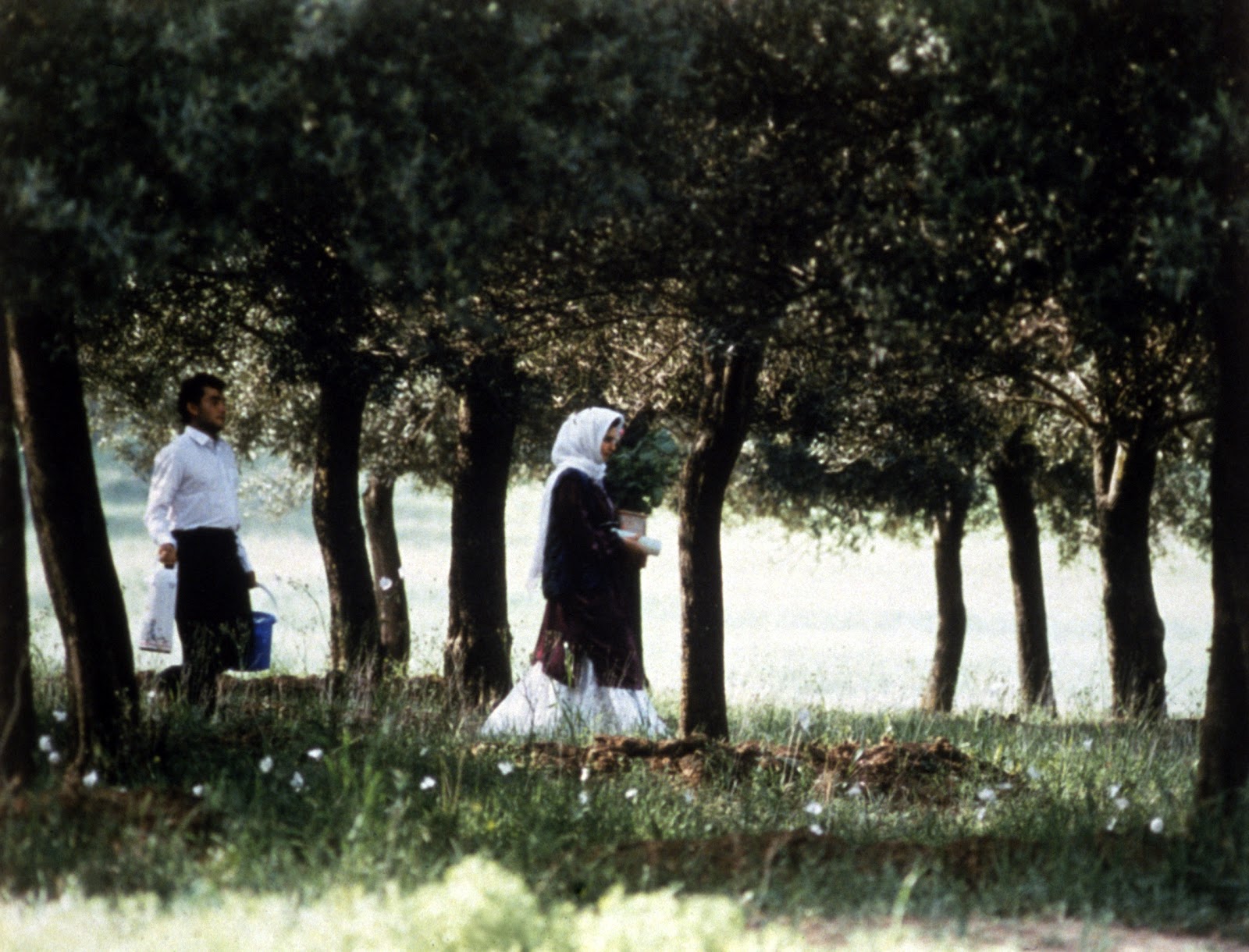Like Someone in Love
by Tobi Haslett

Abbas Kiarostami. Through the Olive Trees. 1994. Feature film, 103 min.
When I heard that the director Abbas Kiarostami had died in Paris this summer, my mind swung to Through the Olive Trees (1994), a film I first saw at nineteen. Such an ugly, pompous time for me — a fresh conscript to radical theory, I was always squinting derisively at things, seizing the “truth” behind them. I bought a Sontag collection, Styles of Radical Will, just for its title, and no less sexy to me were the words “Iranian art house,” a genre of film I knew nothing about but thought it proper to like. And Through the Olive Trees smiled down at me with pitying comprehension. I felt suspended by it, somehow encircled and eluded by its logic, as my arrogance — about art, about film, about my own intellectual prejudices — started to buckle.
You cannot be snooty in the face of this film; its cleverness is so strangely merciful. It’s the last work in a trilogy about Koker, a small village in northern Iran, and references its two earlier counterparts in a supple interweaving of documentary and fiction. Take the opening shot, a quintessential Kiarostami scene in which a man stands in the foreground, legs rooted to the earth, eyes looking straight at the camera. He speaks to us: “I am Mohammad A. Keshavarz, the actor who plays the director. The other actors were recruited on site. We are in Koker, approximately 400, no, 350 kilometers north of Tehran, where last year an earthquake destroyed everything.”
This isn’t just a film within a film, but a Kiarostami within a Kiarostami. The earthquake the actor refers to is the 1990 Manjil-Rudbar quake, which claimed almost 50,000 lives and injured twice as many in northern Iran. Kiarostami’s first film in Koker, Where Is the Friend’s Home? (1987), made before the quake, follows a young boy looking for his classmate in order to return a missing notebook. Following the quake, Kiarostami went back to Koker to shoot Life, and Nothing More… (1992) — whose lead characters are fictionalized versions of the director and his presumed son, looking for the two boys who acted in his first film. Where Is the Friend’s Home? was entirely scripted, but the second film was something else, something forged not by the director but by the events, histories, and rent cloth of existence as it’s sliced through by cataclysm. Villagers act out their own stories for the camera in a smiling simulacrum of reality. The earthquake has toppled everything — even the delicate vessel of Kiarostami’s fiction.
The final work of his trilogy reenacts the shooting of Life, and Nothing More…, and again the people of Koker play themselves. But the action in Through the Olive Trees twirls around a single episode of forbidden desire. Hossein, a former bricklayer, wants to marry Tahereh, a schoolgirl orphaned by the earthquake. He’s illiterate and of a lower class, and Tahereh’s grandmother forbids the marriage. Never mind that the quake has swept everything away, or that now everyone is poor — whole communities having been smashed into a forced classlessness — the old woman clings to her distinctions. Tahereh dares not even say a word to Hossein, a rule that’s broken, with gentle irony, when the film crew descends upon Koker and the two are cast as husband and wife.
The conceit is bold. Of all Kiarostami’s films, this is the most stilted and glibly constructed. But what moved me the first time I saw it, and what still makes me gasp, is the elegance of the execution — Kiarostami’s sly swivel past his own didacticism. The “meta” aspects don’t harden into a brittle exoskeleton; they swim through the film, making it sing. When the camera is rolling (the camera wielded by Keshavarz inside the film, that is), Hossein shouts for tea, or wonders aloud about his socks, barking demands at his would-be wife. But as soon as the scene-inside-the-scene ends he starts mumbling his apologies to Tahereh, telling her that marriage to him wouldn’t be like this at all: “I am not someone who keeps asking, ‘Where are my socks?’” Thrust together by filmic artifice, the couple may very well transcend it and actually become man and wife — but Tahereh is stony. She never responds to Hossein out of character. Her silence is powerfully opaque: inassimilable, indigestible, impervious to narrative.

I’ve always thought of Kiarostami as a director who defies the limits of representation, showing that when life is poured into structures, a little bit always dribbles over the sides. Categories fissure, reality sprints past art — and Kiarostami himself, toiling dutifully within the strictures of the ayatollah’s censors, would hatch his own little escape. His later films were made outside Iran: in Italy (Certified Copy) and Japan (Like Someone in Love). When asked how he imagined his legacy, Kiarostami demurred. “I have not thought about that,” he said, “since my pleasure is in my own existence, not in those works that would remain of me.” There’s an almost Buddhist negation in his reply, or at least a stout commitment to keep striding forward, keep filming, writing, thinking. I thought of Hossein, a doomed romantic born to a world still nostalgic for yesterday. He says to Tahereh in the film’s desperate last scene: “We will build a new house.”